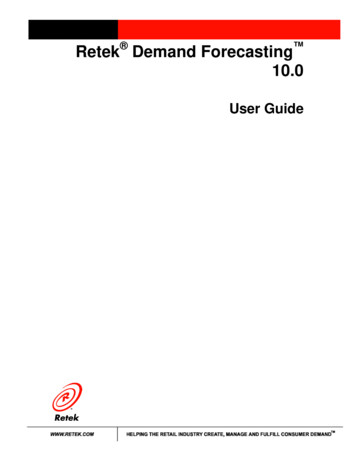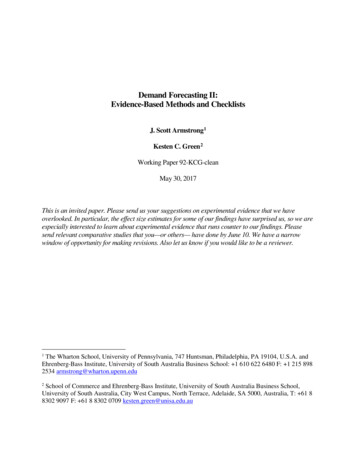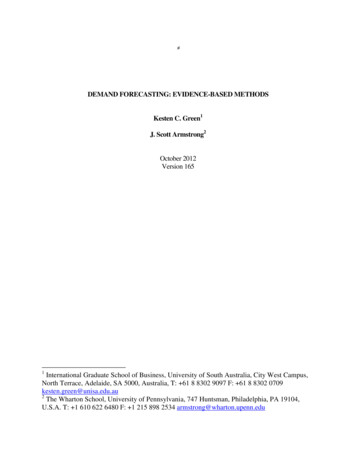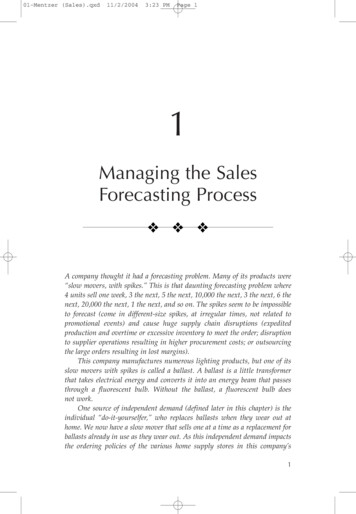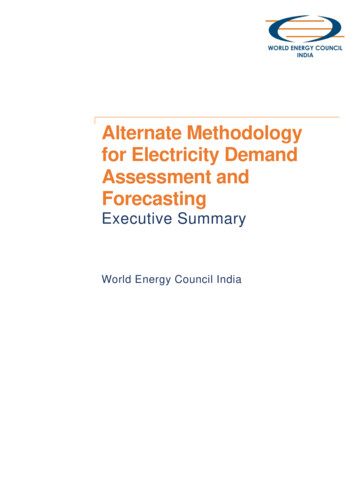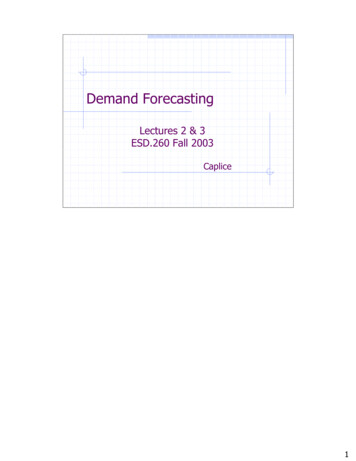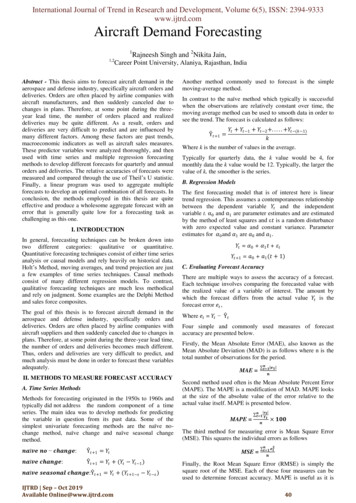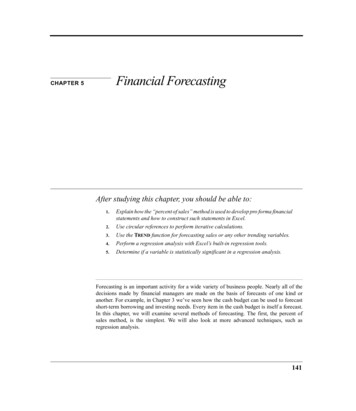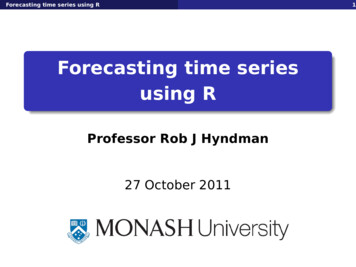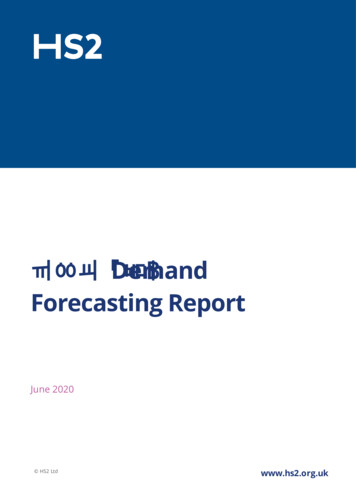
Transcription
PFMv9 DemandForecasting ReportJune 2020 HS2 Ltdwww.hs2.org.uk
High Speed Two (HS2) Limited has been tasked by the Department forTransport (DfT) with managing the delivery of a new national high speed railnetwork. It is a non-departmental public body wholly owned by the DfT.High Speed Two (HS2) Limited,Two SnowhillSnow Hill QueenswayBirmingham B4 6GATelephone: 08081 434 434General email enquiries: HS2enquiries@hs2.org.ukWebsite: www.hs2.org.ukHigh Speed Two (HS2) Limited has actively considered the needs of blind andpartially sighted people in accessing this document. The text will be madeavailable in full on the HS2 website. The text may be freely downloaded andtranslated by individuals or organisations for conversion into other accessibleformats. If you have other needs in this regard please contact High SpeedTwo (HS2) Limited. High Speed Two (HS2) Limited, 2020, except where otherwise stated.Copyright in the typographical arrangement rests with High Speed Two (HS2)Limited.This information is licensed under the Open Government Licence v2.0. To viewthis licence, visit cence/version/2or write to the Information Policy Team, The National Archives,Kew, London TW9 4DU, or e-mail: psi@nationalarchives.gsi.gov.uk. Where wehave identified any third-party copyright information you will need to obtainpermission from the copyright holders concerned.Printed in Great Britain on paper containing at least 75% recycled fibre
PFMv9 Demand Forecasting ReportRevision: Rev01Contents1Introduction1.1Background1.2Note Structure1112Rail Demand Forecasting Methodology2.1Introduction2.2Recorded Growth in Rail Demand Since 2014/152.3Updating the Forecast Years2.4PDFHv6 and WebTAG Guidance Update2.5Demand Driver Updates2235563Forecast Rail Demand3.1Introduction3.2Impacts to the PLANET Long Distance (PLD) Rail Demand3.3Impacts on PLANET South (PS) Forecasts3.4Impacts on PLANET Midland (PM) Forecasts3.5Impacts on PLANET North (PN) Forecasts9991416184Forecast Highway Demand4.1Introduction4.2Future Year Highway Demand Forecasting4.3Future Year Highway Preload Flows4.4Future Year Highway Occupancy Factors20202023245Forecast Air Demand5.1Introduction5.2Future Year Air Demand Forecasts5.3Air Supply Forecasts252525266Third Forecast Year297Quality Assurance318Conclusions32Page i
PFMv9 Demand Forecasting ReportRevision: Rev01List of tablesTable 1: Mapping of PFM sub-models to ORR markets3Table 2: Growth in observed rail demand by sub-model from 2014/154Table 3: Changes to Macro-Economic DDGs between December 2016 and June 2019 6Table 4: Changes to Modal Competition DDGs between December 2016 and June 2019.8Table 5: Change in the future year total Do Minimum PLD rail demand for the first forecast year10Table 6: Change in the future year total Do Minimum PLD rail demand for the second forecastyear11Table 7: Change in demand for key rail movements in PLD for 2026/27 (PfMv7.1) & 2029/30(PfMv9)12Table 8: Change in demand for key rail movements in PLD for 2037/38 (PfMv7.1) & 2039/40(PfMv9)13Table 9: Change in future year PS rail demand for 2026/27 (PfMv7.1) & 2029/30 (PfMv9)14Table 10: Change in future year PS rail demand for 2037/38 (PfMv7.1) & 2039/40 (PfMv9)15Table 11: Change in future year PM rail demand for 2026/27 (PfMv7.1) & 2029/30 (PfMv9) 16Table 12: Change in future year PM rail demand for 2037/38 (PfMv7.1) & 2039/40 (PfMv9) 17Table 13: Change in future year PN rail demand for 2026/27 (PfMv7.1) & 2029/30 (PfMv9) 18Table 14: Change in future year PN rail demand for 2037/38 (PfMv7.1) & 2039/40 (PfMv9) 19Table 15: TEMPRO to PLD Journey Purpose Mappings21Table 16: Growth in highway demand forecasts from the Base Year23Table 17: RTF18 traffic forecasts in billion vehicle miles by road and vehicle type24Table 18: Future Year Air Demand Forecasts25Table 19: Growth in Air demand forecasts from Base Year26Table 20: Mainland UK Airports Modelled within PLANET Long Distance28Table 21: Forecast Do Minimum rail demand matrices – Growth 2039/40 to 2049/50 30Table 22: PLD Forecast Do Minimum air and highway demand matrices – Growth 2039/40 to2049/5030Page ii
PFMv9 Demand Forecasting ReportRevision: Rev011Introduction1.1Background1.1.1The PLANET Framework Model (PFM) is the primary tool for forecasting HS2 demandand calculating the associated benefits and revenue to support the HS2 BusinessCase. Since the release of PFMv7.1 the process of model development has continuedas modelling assumptions are revised and updated, as well as the release of neweconomic growth forecasts.1.1.2One of the key inputs to the PFM are the future year demand forecasts. These areestimated for the rail mode for all sub-models, as well as the highway and air modesfor the PLANET Long Distance (PLD) sub-model. Further information on the structureand modelling approach of the PFM can be found within the Model DescriptionReport.1.1.3HS2 Ltd commissioned the preparation of a revised set of future year rail demandforecasts for use within the PFM. This report sets out the revised exogenous demandforecasts that have been included within PFMv9, summarises the adoptedforecasting approach, and analyses the change in demand forecasts from theprevious model release.1.2Note Structure1.2.1The remainder of this note is structured as follows: Chapter 2: Rail Demand Forecasting Methodology; Chapter 3: Forecast Rail Demand; Chapter 4: Forecast Highway Demand; Chapter 5: Forecast Air Demand; Chapter 6: Third Forecast Year; Chapter 7: Quality Assurance; and Chapter 8: Conclusion.Page 1
PFMv9 Demand Forecasting ReportRevision: Rev012Rail Demand ForecastingMethodology2.1Introduction2.1.1Rail demand forecasts are calculated using an established forecasting system whichapplies the mathematical framework set out in the Passenger Demand ForecastingHandbook (PDFH). This system utilises macro-economic forecasts (such as GrossDomestic Product (GDP), population, and employment) and uses inter-modalcompetition elements (such as car vehicle costs) to grow base year rail demand forthe forecast years.2.1.2Using this methodology, the future year rail demand depends upon both the level ofbase year demand and a series of demand driver generator (DDG) forecasts whichare released by the Department for Transport (DfT) using the latest economicoutlook and TAG recommendations. More information on the adopted forecastingapproach can be found in the latest PFM Model Description Report.2.1.3Since the release of PFMv7.1, there have been several significant updates to thedemand forecasts which are discussed separately in this chapter: Growth in Base Demand: The Office for Rail and Road (ORR) publishes statisticsof recorded growth in rail demand which has been used to identify observedgrowth 2014/15 and 2018/19. These uplifts have been applied to the basematrices for 2014/15 and have been incorporated into the forecasting to betterrepresent the forecast demand;Updated Second Forecast Year: In order to maintain the economic appraisalapproach, an appraisal window of 20 years from the point of appraisal needs tobe maintained. With the point of appraisal now 2019/20, the second forecast yearhas also moved from 2037/38 to 2039/40;PDFHv6: A new release of the PDFH contains new guidance on how to forecastrail demand. This includes new guidance elasticities as well as demand driversthat were not in the previous version of the guidance marking a significant shift inmethodology; and,Revised Demand Drivers: The June 2019 release of rail demand drivers have beenused to develop new demand forecasts. The revised demand drivers includemacro-economic drivers (e.g. GDP and employment) as well as inter-modalfactors such as vehicle operating costs.Page 2
PFMv9 Demand Forecasting ReportRevision: Rev012.1.4These updates cumulatively have a significant impact on the forecast demand that isinput to the PFM and make isolating the impacts of individual updates complex. Thefollowing sections provides an overview of each update.2.2Recorded Growth in Rail Demand Since 2014/152.2.1As the year of appraisal moves further from the base year for rail demand, latestobserved data is used to ensure that the level of demand within the PFM is as up todate as possible. As such, for PFMv7.1 and for PFMv9, the Base demand is upliftedfrom 2014/15, to 2016/17 and 2018/19 respectively, using observed data publishedby the Office of Rail and Road (ORR). Table 12.6 on the ORR data portal reportsgrowth by distinct rail markets which have been mapped to PFM sub-models asshown in Table 1.Table 1: Mapping of PFM sub-models to ORR marketsPFM Sub-ModelORR MarketPLANET Long DistanceLong DistancePLANET South*London and South EastPLANET MidlandsRegionalPLANET NorthRegional*PLANET South also covers the area of the South West,however the growth for London and South East has beenapplied to all of PLANET South. This should not significantlyaffect the appraisal of HS2.This methodology is applied to the PFMv9 update, with uplift factors calculated oreach of the sub-models according to the ORR markets shown in Table 1. The upliftsapplied have been calculated using the data included in Table 12.6 on the ORR dataportal. These uplifts are shown in Table 2 and compared with similar uplifts used inPFM v7.1. (Note that at the time of PFMv7.1 forecasting, only a high-level growthtrend was available and so this was used equally across all sub-models.)Page 3
PFMv9 Demand Forecasting ReportRevision: Rev01Table 2: Growth in observed rail demand by sub-model from 2014/152.2.2PFM Sub-ModelPFMv7.1 Growth to2016/17PFMv9 Growth to 2018/19PLANET Long Distance6.0%9.3%PLANET South6.0%5.4%PLANET Midlands6.0%7.7%PLANET North6.0%7.7%The new growth factors have been applied in PFMv9 and provide a new platformfrom which to forecast rail demand.Accounting for change in car availability between 2014/15 and 2018/192.2.3The rail demand for the PLD, PLANET Midlands (PM) and PLANET North (PN) submodels are segmented by car availability, and therefore the rail demand for tripswhich have the use of car as an alternative mode is presented in a separate matrixfrom trips which do not have car as an available alternative.2.2.4Car availability is forecast within TEMPRO, which designates - out of the total numberof households across Great Britain – the number of households which have access toa car, or number of cars; as well as those with no access to a car. This forecast overtime is used within the PDFH mathematical framework to forecast future year raildemand. Car availability is forecast to increase over time as household incomeincreases and more households have access to a car.2.2.5To reflect increased car availability over the period 2014/15 to 2018/19, demandmust be redistributed from the non-car available (NCA) matrices to the car available(CA) matrices within each sub-model. This process is used within the forecastingapproach to consider the change in car availability from the base year to the futureyear.2.2.6A matrix of factors is produced based on TEMPRO data to redistribute demand fromthe NCA matrices to the CA matrices. The redistribution factors calculate theproportion of households without access to a car in 2018/19 and compare this withthe same proportion in 2014/15 to derive a factor to apply to the NCA demandmatrices. This factor is less than one for all segments of the PLD, PM and PN submodels, and redistributes rail demand in the NCA matrices to the CA matrices usingthe following formulae:Page 4
PFMv9 Demand Forecasting ReportRevision: Rev01 For PM and PN, multiply the NCA matrix by the (origin) redistribution factor, andadd to the CA matrix the NCA matrix multiplied by 1 minus the (origin)redistribution factor, i.e. New CA matrix CA matrix NCA matrix*(1-factor) New NCA matrix NCA matrix*factorFor PLD, as “from home” and “to home” demand is separated, the demandmatrices need to be multiplied by the average of the origin and destinationredistribution factors, i.e. New CA from CA from (NCA*(1-(origin factor destination factor)/2)/2) New CA to CA to (NCA*(1-(origin factor destination factor)/2)/2) New NCA NCA* (origin factor destination factor)/22.3Updating the Forecast Years2.3.1The first forecast year in PFM v9 has been moved from 2026/27 to 2029/30, to reflectthe current delivery-into-service date for the first phase of the scheme.2.3.2The economic appraisal of HS2 requires there to be a 20-year forecasting horizonfrom the point of appraisal over which to measure the benefits of the scheme. This isconsistent with the economic appraisal approach for investments in railinfrastructure. The 20-year appraisal horizon begins at the point the economicappraisal is being conducted i.e. the present financial year. In order to maintain the20-year economic appraisal horizon, the second forecast year for PFMv9 requiredupdating from 2037/38 in PFMv7.1, to 2039/40 in PFMv9.2.3.3This involves not only changing the year to which the rail demand forecasts aremade, but also making sure that the model contains all the parameters required e.g.vehicle operating costs are year specific in PFM inputs.2.4PDFHv6 and WebTAG Guidance Update2.4.1Since the release of PFMv7.1, a new release of PDFH (v6) has resulted in changes tothe rail demand forecasting guidance recommended by WebTAG and the DfT. Thenew guidance not only includes revisions to recommended elasticity values, it alsorecommends some material changes to use of demand drivers that includes use ofnew drivers. The update to the guidance is a combination of advice from the latestversion of PDFH and the Rail Demand Forecasting Estimation (RDFE) study.2.4.2The revised guidance affects elasticities applied to demand drivers, in several casesreducing the elasticities which makes rail demand less sensitive to changes.Page 5
PFMv9 Demand Forecasting ReportRevision: Rev01Elasticities to changes in rail fares have also changed having previously been basedupon PDFHv4 (as per previous guidance).2.4.3In addition to the changes in elasticities, the revised guidance introduces some newdemand drivers such as Employment Index, Participation, and GJT Trend, and revisesthe significance of other demand drivers for some flows, such as Car Availability.2.4.4The cumulative impact of these changes to the demand forecasting methodologyand the forecast demand drivers, has a material impact on the volumes and patternsof demand growth relative to previous forecasts. Given the complexity anddynamism within the forecasting, it is not simple to untangle which change hascontributed to some significant changes in the demand forecasting.2.4.5It is recommended that for further detailed information on the updates to theforecasting guidance, please consult WebTAG and PDFH directly.2.5Demand Driver Updates2.5.1The DfT’s June 2019 DDG set includes the latest forecasts at that time in terms of theeconomic outlook for the country in the short-term. This is informed by the March2019 release of the Office for Budget Responsibility (OBR) Economic & Fiscal Outlook,which provides forecasts for GDP and employment.2.5.2PFMv7.1 used the December 2016 DDG set to forecast future year rail demand; andsince then many of the other demand driver forecasts have also been updated toincorporate the latest assumptions. A comparison between the data used within thetwo sets of DDGs is presented in Table 3 and Table 4.Table 3: Changes to Macro-Economic DDGs between December 2016 and June 2019Demand DriverDecember 2016 DDGJune 2019 DDGGDPCEBR October 2016forecasts constrained to:CEBR March 2019 forecastsconstrained to:OBR Economic & FiscalOutlook November 2016to 2020/21.OBR Economic & Fiscal OutlookMarch 2019.Beyond 2020/21 shortterm forecasts areextrapolated.NOTE: this is input to theforecasting process as GDP PerCapita using the Populationassumptions below.NOTE: this is input to theforecasting process as GDPPer Capita using thePage 6
PFMv9 Demand Forecasting ReportRevision: Rev01Demand DriverDecember 2016 DDGJune 2019 DDGPopulation assumptionsbelow.PopulationNTEMv6.2 constrained toCEBR October 2016,constrained at a nationallevel by:ONS Principle Populationforecast 2014 (ReleasedNovember 2015) for 2015– 2020.After 2020 short termforecasts areextrapolated.EmploymentNTEMv7.2 constrained to CEBRMarch 2019, constrained at anational level by:ONS Population data up to 2017taken from ONS estimates.ONS Principal Populationforecast 2016 based (releasedNov 2017) from 2018.NTEMv6.2 constrained toCEBR October 2016forecasts constrained to:NTEMv7.2 constrained to CEBRMarch 2019 forecasts constrainedto:OBR Economic & FiscalOutlook November 2016to 2020/21.OBR Economic & Fiscal OutlookMarch 2019.Beyond 2020/21 shortterm forecasts areextrapolated.ParticipationThis driver is part of newforecasting guidance fromPDFHv6 and so was notincluded in the previous setof demand drivers.This driver contains the number ofworkers and working agepopulation by NTEMv7.2 zone.WorkersThis driver is part of newforecasting guidance fromPDFHv6 and so was notincluded in the previous setof demand drivers.This contributes to theparticipation driver. Workersmeans workplace basedemployment. Taken from Tempro(NTEMv7.2) and then constrainedto CEBR regions (Mar 2019), thenconstrained to OBR nationalemployment (March 2019).Working AgePopulationThis driver is part of newforecasting guidance fromPDFHv6 and so was notincluded in the previous setof demand drivers.This contributes to theparticipation driver. Taken fromTempro (NTEMv7.2) andconstrained to CEBR (Mar 2019)and then national from ONSpopulation projections (2016).Page 7
PFMv9 Demand Forecasting ReportRevision: Rev01Demand DriverDecember 2016 DDGJune 2019 DDGPopIndexThis driver is part of newforecasting guidance fromPDFHv6 and so was notincluded in the previous setof demand drivers.Contains info from pop as above,from workers as above, carownership as above, Occupationand sector are from CEBR.EmpIndexThis driver is part of newforecasting guidance fromPDFHv6 and so was notincluded in the previous setof demand drivers.Contains info from employment asabove, from workers as above, carownership as above, Occupationand sector are from CEBR. Age isfrom 2016 based populationprojections.Table 4: Changes to Modal Competition DDGs between December 2016 and June 2019.DemandDecember 2016 DDGJune 2019 DDGCar CostData based on unpublished carcost figuresBased on unreleased WebTAGdatabook.Bus Fare & BusServiceDfT Local Forecasts to 2049/50Data provided by DfT LocalEconomics.LondonUndergroundFaresRPI 0% 2014 – 2016, RPI 1% allother years. Nominal freezeapplied 2017 – 2020RPI 0% 2014 – 2016, RPI 1% allother years. Nominal freezeapplied 2017 – 2020Car AvailabilityNTEMv6.2NTEMv7.2National RailFaresRPI 0% 2014 – 2020; RPI 1%from 2021 onwardsRPI 0% 2014 – 2020; RPI 1% from2021 onwardsCar & BusJourney TimesTAG Databook December 2015Based on WebTAG databook May2019.DriverPage 8
PFMv9 Demand Forecasting ReportRevision: Rev013Forecast Rail Demand3.1Introduction3.1.1The June 2019 DDG set has been used within EDGE to forecast future year raildemand for 2029/30 and 2039/40 from 2018/19 and applied to the base yearmatrices grown by observed rail demand growth since 2014/15.3.1.2This chapter presents the impacts to the future year rail demand for each of the submodels contained within the PFM, by comparing the resulting future year demandforecasts with the forecasts from the demand matrices produced from theDecember 2016 DDGs which were included in PFMv7.1. The comparisons within thischapter compare the demand forecast for PFMv9 directly against the demandforecast for PFMv7.1 as output from the EDGE process.3.1.3The changes to demand drivers outlined in the previous chapter show that there aresome significant changes to individual drivers which are expected to influence thematrices put into the model.3.1.4In general, one would expect an increase in demand between the PfMv7.1 2026/27matrix and PfMv9 2029/30 matrix based on annual background growth, not just thechange in demand drivers.3.2Impacts to the PLANET Long Distance (PLD) Rail DemandImpacts on the PLD Future Year Matrix Totals3.2.1Table 5 presents the changes to the PLD future year Do Minimum rail demandmatrix totals as a result of using the June 2019 DDG data set to forecast rail demandfrom the Base to 2029/30 for PfMv9. Overall there is a net 5% change in PLD futureyear rail demand at an aggregate level. This may primarily be attributed to the factthat he first forecast year is 3 years later in PfMv9 than in PfMv7.1. All journeypurposes experience an increase in demand, although the increase in Commutedemand is slightly lower than for other journey purposes.Page 9
PFMv9 Demand Forecasting ReportRevision: Rev01Table 5: Change in the future year total Do Minimum PLD rail demand for the first ce%Commuting Non-Car Available12,81814,0961,27810%Commuting Car Available fromHome50,91654,4003,4847%Commuting Car Available toHome50,67054,1903,5207%Business Non-Car Available *----Business Car Available fromHome86,19991,7535,5546%Business Car Available to Home66,86571,0554,1906%Leisure Non-Car Available45,38949,5584,1699%Leisure Car Available fromHome108,650114,7996,1496%Leisure Car Available to Totals* The Business Non-Car Available trip purpose has zero demand; but the matrix totalreporting is retained for completeness.3.2.2Table 6 presents the changes to the PLD future year Do Minimum rail demandmatrix totals as a result of using the June 2019 DDG data set to forecast rail demandfrom the Base to the second forecast year. Overall there is forecast to be a 2%decrease in rail demand in the second forecast year which is notable given that inPFMv9 the second forecast year is later than in PFMv7.1 which would ordinarilyimply more growth. This is the result of the changes in the forecasting methodologyintroduced by PDFHv6, as well as revisions to the demand drivers.Page 10
PFMv9 Demand Forecasting ReportRevision: Rev01Table 6: Change in the future year total Do Minimum PLD rail demand for the secondforecast ting Non-Car Available13,51514,4489337%Commuting Car Available fromHome59,09958,853-2460%Commuting Car Available toHome58,87058,659-2110%Business Non-Car Available *----Business Car Available fromHome109,372105,181-4,191-4%Business Car Available to Home85,20181,344-3,857-5%Leisure Non-Car Available52,06054,5082,4485%Leisure Car Available fromHome136,089132,703-3,386-2%Leisure Car Available to ceSub-Totals* The Business Non-Car Available trip purpose has zero demand; but the matrix totalreporting is retained for completeness.Page 11
PFMv9 Demand Forecasting ReportRevision: Rev01Impacts on Key Rail Movements3.2.3The impact of the reforecasting for key movements is presented in Table 7 for thefirst forecast year. Table 7 shows total daily trips in both directions from the EDGEdemand forecasts.Table 7: Change in demand for key rail movements in PLD for 2026/27 (PfMv7.1) & 9/30)Central London - Birmingham11,74412,2755315%Central London - Manchester10,39610,9986026%Central London - Leeds6,2576,5472905%Central London - Glasgow1,8871,963764%Central London - Liverpool4,1154,2721574%Central London - Newcastle3,4823,7032216%Central London - Edinburgh3,5523,7962447%Birmingham - Manchester1,4551,524695%Birmingham - Glasgow19620263%Birmingham - Leeds481494133%Birmingham - Newcastle221234136%Birmingham - Edinburgh20621152%Manchester - Glasgow522543214%Leeds - Newcastle893939465%DifferencePage 12
PFMv9 Demand Forecasting ReportRevision: Rev013.2.4Table 8 shows the impact of the new EDGE demand forecasts on key zone to zonemovements for HS2 for the second forecast year. The levels of growth observed onthese flows in the second forecast year is notably lower than in the PFMv7.1.Table 8: Change in demand for key rail movements in PLD for 2037/38 (PfMv7.1) & 9/40)Central London - Birmingham15,49213,868-1,624-10%Central London - Manchester13,50612,452-1,054-8%Central London - Leeds8,1397,362-777-10%Central London - Glasgow2,4832,205-278-11%Central London - Liverpool5,3444,782-562-11%Central London - Newcastle4,4434,180-263-6%Central London - Edinburgh4,5564,286-270-6%Birmingham - Manchester1,7821,769-13-1%Birmingham - Glasgow243235-8-3%Birmingham - Leeds596576-20-3%Birmingham - Newcastle27127542%Birmingham - Edinburgh255245-10-4%Manchester - Glasgow642634-8-1%Leeds - Newcastle1,0751089141%DifferencePage 13
PFMv9 Demand Forecasting ReportRevision: Rev013.3Impacts on PLANET South (PS) Forecast3.3.1Table 9 presents the changes to the PS future year matrix totals as a result of usingthe June 2019 DDG data set to forecast rail demand from the base of 2018/19 to2029/30. Overall there is a 6% change in the PS future year rail demand.Table 9: Change in future year PS rail demand for 2026/27 (PfMv7.1) & 2029/30 (PfMv9)PFMv7.1PFMv9Difference% Difference(2026/27)(2029/30)Business PA1,720,9031,859,392138,4898%Business AP36,99040,6313,64110%Leisure PA187,234183,188(4,046)-2%Leisure AP11,73412,3956616%Commute PA191,778189,111(2,667)-1%Commute -TotalsPA Production AttractionAP Attraction to ProductionPage 14
PFMv9 Demand Forecasting ReportRevision: Rev013.3.2Table 10 presents the resulting changes to the PS future year matrix totals for thesecond forecast year. Overall there is a 9% increase in total PS rail demand. PLANETSouth demand growth will be strongly influenced by different demand drivers due tospatial extent and elasticities to the long-distance matrices in PLD and hence we seedifferent patterns in change.Table 10: Change in future year PS rail demand for 2037/38 (PfMv7.1) & 2039/40 (PfMv9)PFMv7.1PFMv9Difference% Difference(2039/40)(2039/40)Business PA1,844,2912,110,378266,08714%Business AP40,04946,0185,96915%Leisure PA244,816216,277(28,539)-12%Leisure AP14,97414,637(337)-2%Commute PA242,099220,504(21,595)-9%Commute 9%Sub-TotalsPA Production AttractionAP Attraction to ProductionPage 15
PFMv9 Demand Forecasting ReportRevision: Rev013.4Impacts on PLANET Midland (PM) Forecasts3.4.1Table 11 presents the changes to the PM future year matrix totals as a result of usingthe June 2019 DDG data set to forecast rail demand from the base year of 2018/19 to2029/30. Overall there is a 5% increase in PM future year rail demand, which isreflected across all journey purposes. This is associated more with the increase inforecast year rather than the demand drivers.Table 11: Change in future year PM rail demand for 2026/27 (PfMv7.1) & 2029/30 (PfMv9)PFMv7.1PFMv9(2026/27)(2029/30)Difference% DifferenceBusiness CA63,34765,8332,4864%Business NCA10,64912,3551,70616%Leisure CA5,4295,5681393%Leisure NCA83094611614%Commute CA5,9896,1491603%Commute 1,9184,7425%Sub-TotalsCA Car AvailableNCA No Car AvailablePage 16
PFMv9 Demand Forecasting ReportRevision: Rev013.4.2Table 12 presents the resulting changes to the PM future year matrix totals for thesecond forecast year. Overall there is a 3% decrease in total PM rail demand in thesecond forecast year, which is primarily focused on Business journey purposes.Table 12: Change in future year PM rail demand for 2037/38 (PfMv7.1) & 2039/40 (PfMv9)PFMv7.1PFMv9Difference% Difference(2037/38)(2039/40)Business CA75,06471,093(3,971)-5%Business NCA11,60813,3071,69915%Leisure CA6,7746,388(386)-6%Leisure NCA9511,08213114%Commute CA7,4357,080(355)-5%Commute otal102,897100,174(2,723)-3%Sub-TotalsCA Car AvailableNCA No Car AvailablePage 17
PFMv9 Demand Forecasting ReportRevision: Rev013.5Impacts on PLANET North (PN) Forecasts3.5.1Table 13 presents the changes to the PN future year matrix totals as a result of usingthe June 2019 DDG data set to forecast rail demand from the base of 2018/19 to2029/30. Overall there is a 2% increase in PN future year rail demand, primarilyfocused on Business. This reflects the similar trends observed in other PLANETmodels.Table 13: Change in future year PN rail demand for 2026/27 (PfMv7.1) & 2029/30 (PfMv9)PFMv7.1PFMv9Difference% Difference(2026/27)(2029/30)Business CA103,663103,9903270%Business NCA21,22623,8422,61612%Leisure CA7,2487,247(1)0%Leisure NCA1,3441,50115712%Commute CA12,49212,565731%Commute 48,447151,9323,4852%Sub-TotalsCA Car AvailableNCA No Car AvailablePage 18
PFMv9 Demand Forecasting ReportRevision: Rev013.5.2Table 14 presents the resulting changes to the PN future year matrix totals for thesecond forecast year. Overall, there is a 4% decrease in total PN rail demand, withreductions across all journey purposes.Table 14: Change in future year PN rail demand for 2037/38 (PfMv7.1) & 2039/40 (PfMv9)PFMv7.1PFMv9Difference% Difference(2037/38)(2039/40)Business CA117,459108,851(8,608)-7%Business NCA21,96224,8472,88513%Leisure CA8,7988,140(658)-7%Leisure NCA1,4911,67818713%Commute CA14,96614,152(814)-5%Commute )-2%Tota
PFMv9 Demand Forecasting Report Revision: Rev01 Page 1 1 Introduction 1.1 Background 1.1.1 The PLANET Framework Model (PFM) is the primary tool for forecasting HS2 demand and calculating the associated benefits and revenue to support the HS2 Business Case. Since the release of PFMv7.1 the process of model development has continued
